
|
The world of non-commercial film and A-V |
Events Diary | Search | ||
| The Film and Video Institute | | ||||
The making of Melissa

|
I first met Melissa ten years ago when she was one of my personal trainers. Around that time she got interested in the trapeze and after a while really got the bug and went off to the circus. From time to time I considered making a film about her and when she came back from travelling and began appearing regularly as a featured artist at a night club in the West End of London I determined to take advantage of the opportunity. I first checked with Melissa that she had no objections and also of course with the owners of the club who luckily, I knew, since they trained in the same gym! |
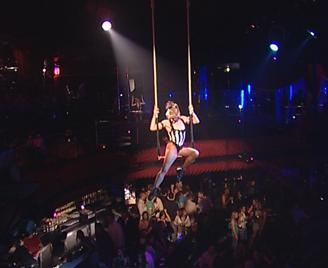
Preparation
I had no clear idea of the problems I would encounter and even whether I would be able to get material good enough to form the basis of a film. I had to decide whether to present the action on the trapeze in an impressionistic style cut to music as the end product or adhere to a more formal documentary style imparting information that an audience would wish for. In the end it turned out to be a bit of both, which more often than not seems to be my preferred formula nowadays.
I suspected that my opportunities of obtaining dramatic footage of Melissa performing might be limited both for technical and logistical reasons so I determined firstly to ‘test the water’ and start at the club since if I had serious problems in obtaining decent pictures under the prevailing conditions there would be no film.
I made a daytime visit to talk to key people like the duty manager for the night of my first attempt and the security chief and I did some checks on the light levels that would be prevalent at night which I found a bit too low for comfort. I was also somewhat perturbed that Melissa performed only for about six minutes allowing time for only one camera set up per visit.
The Cirque Club operates in the old Hippodrome in London’s Leicester
Square which was, in the recent past, a theatre and further back an old circus
building. There is a high roof enabling the club to be configured on many
different levels apart from providing plenty of space to rig trapeze equipment.
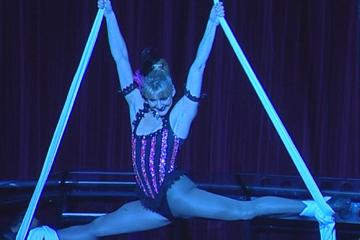
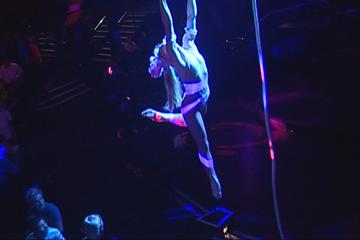
Filming at a night club
Melissa usually performed at around one o’clock in the morning so I found myself at 11 o’clock one evening (at about my habitual bedtime!) on the corner of Leicester Square, which at that time is teeming with youngsters looking young enough to be my grand daughters, encumbered with bulky and heavy film gear trying to negotiate my entrance to the club with some seriously menacing security guards all with the statutory earpiece in contact with who knows who.
Luckily my earlier contact spotted me and ushered me through the lines but still requiring me to pass through the metal detector airport style.
The noise level from the music that greeted me inside was quite unbelievable leading me to believe that I would be completely deaf by the time I had completed the production!
The manager radioed Melissa and she met me and I dragged my gear out to the back stairs and climbed two floors to her dressing room where we discussed the schedule. She was due to perform at 12.30 and was on the static trapeze so I went to my pre planned camera position to set up. As mentioned there were several different levels and balconies which provided very good and varied vantage points but I could only use one on any given evening because there was not time to change and set up due to the short duration of Melissa’s performance. In order to be able to access all the various ‘privilege’ areas without being savaged by a guard I had a special wrist band which magically ensured that all the silk ropes were lifted for me wherever I went!
The lights on Melissa, whilst not quite what I wanted were adequate and my pictures were acceptable. The audio was certainly not. Firstly the music they played for her performances was not what I would choose to match the action and it was copyright material (clubs obtain special licenses in this respect) so I knew I had work to do on this aspect.
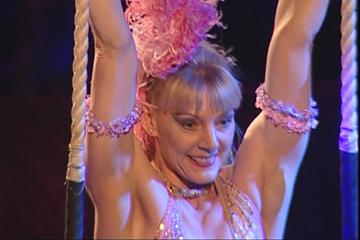
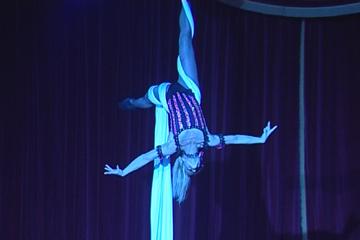
Getting close
Once I had established that performance footage was obtainable I embarked on the task of covering other aspects of Melissa’s artistic activities such as training and fitness.
She does all her training at the well established facility Circus Base in the East End of London and here I had fewer logistical problems but had to contend with lower available light levels.
Filming someone on a swinging trapeze is not straightforward. If you try and follow the action close up you either film from straight ahead keeping the camera static and face the problem of focus changing or you shoot from side on and try and swing the camera with the trapeze.
I had wanted to catch Melissa’s voice whilst swinging but she was understandably reluctant to have a transmitter clipped to her along with her other more essential equipment!
During her lessons I attached the radio microphone to her instructor. I generally try and use an additional mic. for ambient sound whenever I am filming and during editing levels of different tracks can be adjusted obviously favouring the track containing speech.
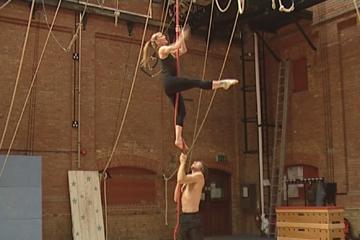
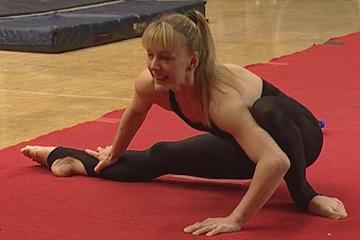
Melissa performs well to camera and I used quite a bit of this to tell her story but for the main narrative I employed my preferred option which entails encouraging the subject to talk about themselves quietly in a relaxed environment and utilising the sentences that I required for a given section.
One of the problems I always encounter with this type of film is deciding when to stop shooting.
I am aware of the general antipathy from competition organisers to lengthy films but I had an interesting subject and information to impart which I was sure audiences would want. Once I had covered the training, preparation and performance I started the tricky process of structuring the film in my mind.
Whilst I had the requisite footage to tell the story I am always conscious of the need to construct sequences throughout a film that will stimulate interest and make the audience sit up and wonder what will come next. This is where music is so important for me and where much of my effort is directed.
Music
As I stated earlier I was determined to avoid any copyright issues and remembering an encounter I had with a representative of audio network plc at last year’s Production Show, I contacted them. I had already played the ‘sampler’ disc I had been given but it sounded like all the other samplers and I was not impressed. However they explained that this did not give a true impression of their range and I opened an account with them and got the full library – over 100 CD’s – and wow, what a selection! I had to work at it but eventually found all the bits and pieces I needed to compile my music tracks to match the action.
The beauty of such a library is that it is compiled especially for film makers (mostly of commercials) and contains little ‘whizzes’,‘pops’, and ‘beats’ that are so helpful to an editor when trying accurately to match unusual action.
Once compiled I prepared a log of tracks used and the firm quoted a fee (modest) giving me worldwide clearance. Probably over the top some might think but people seem to be getting very twitchy regarding copyright so I thought I’d go the professional route although in the past I relied on the splendid IAC Copyright Clearance Scheme which goes a long way in protecting those that subscribe to it from copyright issues.
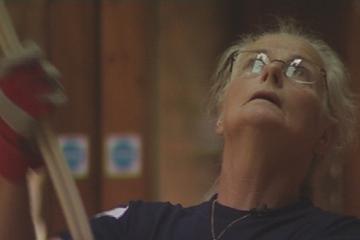
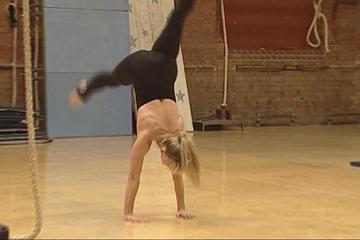
Structuring the film
Having arrived at a ‘rough cut’ I then tested my judgement by showing a small number of people (some in the industry) a print on a decent size plasma screen.
It is important to select these ‘guinea pigs’ carefully since you need hardhearted opinions not plaudits. I sometimes heed the advice and tweak here and there and re master a copy, sometimes not.
I do find though that repeated viewings, especially in the company of critics, helps to highlight faults which are not obvious when running the film from the editing computer to a small monitor. Finally I have to make a decision on based on my own gut feeling and the consensus of my selected viewers.
The problem here is that they (and I) see the film in isolation and whilst it may appear a rounded and satisfying work in that context, judges and audiences at festivals see the piece in a programme of other films, and that is where the dilemma presents itself.
I am often told to have the courage of my convictions and I take this advice but this does attract criticism and I hear the comment “too long” too often for me to feel comfortable. When I challenge the statement and enquire where the cuts should come I get no concrete suggestion and in fact no willingness to lose any specific scene.
Actually with this film a well known professional producer actually wanted me to add a scene but I disagreed. I believe that it is the festival programme construction and context that creates the dilemma.
I sometimes make two or even three versions in order to avoid this problem, but find it artistically unsatisfying. My strong feeling is to encourage festival organisers to be tougher in the judging and selection process so as to include fewer films in their award shows, or to request an extract(s) of a film they don’t want to show in its entirety, such an extract to be cut by the producer themselves.
Anyhow I finally settled on a version I was satisfied with and it runs for 22 minutes and since I owed thanks to a number of people the credits run for longer than I would like. I tried to maintain interest by incorporating an unusually lit empty trapeze as background and some striking music but credits are a way of acknowledging help without which the film could not be made. Mind you most amateur films overdo titles and credits; professionals are in a different position since there are contractual obligations to fulfil.
As a matter of interest Melissa is contemplating returning to the circus for one last brief fling but not in this country, if you want to see her perform see the film!
- Michael Slowe Sep 2005
Share your passions.

Share your stories.